Dunmoe
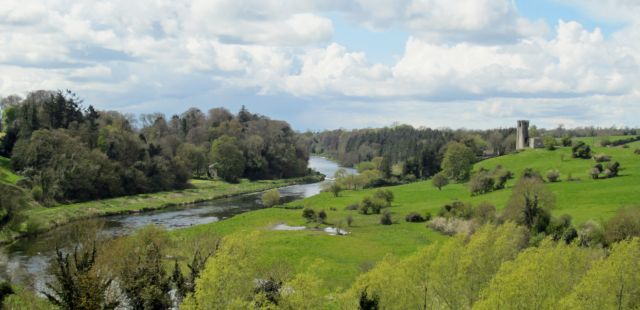
Dunmoe Castle viewed from Ardmulchan (photo ©N&DHS)
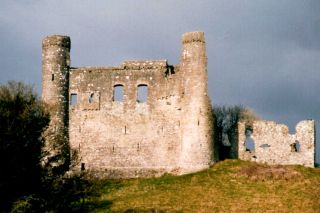
Dunmoe Castle
commands a
spectacular location
on high ground overlooking
the
River Boyne.
The present structure has all the characteristics of an Anglo Norman keep c. 15th -16th century. It was originally a rectangular shaped edifice with a tower at each corner. Two of these towers have crumbled away, as has the entire back part of the castle.
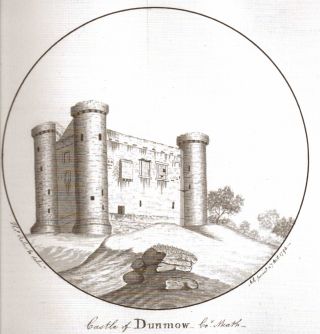
(above) 18th cent. drawing of Dunmoe by Austin Cooper, and (top of page) the castle as it stands today. (Note the window with what appears to be broken glass in the Cooper drawing in what was probably the main living room on the first floor.)
Tradition has it that a souterrain or underground passage leads from it to the opposite side of the Boyne.
Oliver Cromwell is reputed to have taken a passing shot at in from the opposite side of the Boyne, but did not think it worthy of further notice.
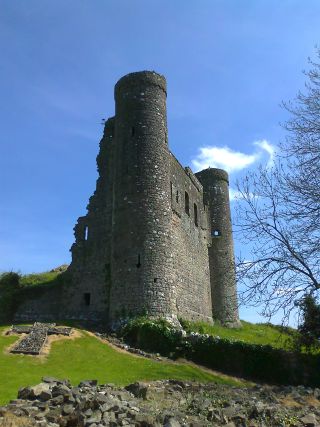
Its last lord was d'Arcy, whose name is usually associated with it. George d'Arcy, it is said,
entertained King James
on the night before the Battle of the Boyne and
King William on the night after it.
This change of loyalty or pragmatic self interest
inspired the couplet:
"Who will be king, I do not know,
But I'll be d'Arcy of Dunmoe."
Besides the castle, lie the ruins of a medieval chapel
(below right) which contains the mausoleum of the d'Arcy family.
Its font is in St. Oliver's Church in Navan.
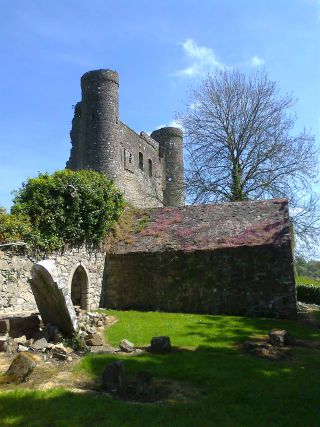
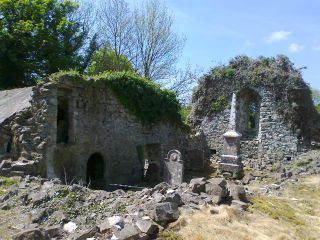
Sources:
The Beauties of the Boyne and Blackwater, William Wilde, Dublin 1849
Cooper's Ireland, Peter Harbison, The O'Brien Press Dublin 2000
Photos: © Navan & District Historical Society
*******
Archaeological Inventory of County Meath, compiled by Michael J. Moore, (Dublin 1987),
p. 135
1394 - Dunmoe - OS 25:7:3 (69.8, 45.1) 'Church (in ruins)' OD 100 - 200 N 9011, 7019
Church - Nave and chancel possibly divided. W. wall and part of S wall with mural staircase to rood loft survive (L. c. 17m, W 6.8m) Two doorways in S wall towards W end. Burial vault added. Font (1561) now at Navan. SMR 25:18 16/10/1984
p.151
1561 - Blackcastle OS 25:6:6 (44.0, 33.5) Not marked OD 100-200 N 8745, 6894
Font - In St. Oliver Plunket RC church is the plain font (Roe 1968, 115) which was once at Dunmoe Castle (1394) SMR 25:38 17/12/1985
p.171
1735 - Dunmoe - OS 25:8:1 (69.8, 45.1) 'Dunmoe Castle (in ruins)' OD 100-200 N 9015, 7020
Castle - Rectangular structure with circular towers at the angles, only two of which survive. Ground floor buried but was vaulted and had a loft. Stairs in SW tower which has key-hole gun loop. First floor has large windows. Two-storey gables building with over at fround floor arrached to E may be eighteenth century. Church (1394) nearby. SMR 25:18 16/10/1984.
********
The Lewis Topographical Directory was first published in 1837 in two volumes, with an accompanying atlas. The first edition is available online. A second edition was published in 1842.
Lewis relied on the information provided by local contributors and on the earlier works published such as Coote's Statistical Survey (1801), Taylor and Skinner's Maps of the Road of Ireland (1777), Pigot's Trade Directory (1824) and other sources. He also used the various parliamentary reports and in particular the census of 1831 and the education returns of the 1820s and early 1830's. Local contributors were given the proof sheets for final comment and revision. The names of places are those in use prior to the publication of the Ordnance Survey Atlas in 1838. Distances are in Irish miles (the statute mile is 0.62 of an Irish mile).
Dunmoe, a parish, in the barony of Morgallion, county of Meath, and province of Leinster, 2 miles (N. N. E.) from Navan, on the road to Slane; containing 112 inhabitants. The castle was built by Hugh de Lacy, and in 1641 was surrendered by Capt. Power to the insurgents, in obedience to a forged order from the Lords Justices. It was partly rebuilt in the 17th century, and is an oblong massive pile, flanked with towers at the angles, now belonging to the D'Arcy family. The parish is in the diocese of Meath; it is a rectory, forming part of the union of Stackallen, and the tithes amount to £81. 10. In the R. C. divisions it is part of the union or district of Slane.
********
Slater's Directory, 1894
Dunmoe, a parish in co. Meath, barony of Lower Navan, union of Navan, diocese of Meath, 2 miles north east from Navan station on the Midland Great Western and the Great Northern railways, containing 1 townland, on the river Boyne. Dunmoe Castle is Anglo Norman of the 17th century. The area comprises 975 acres ; the population in 1891 was 56.
Jameson —, Dunmoe lodge.
Commins, Joseph, miller, Dunmoe mill.